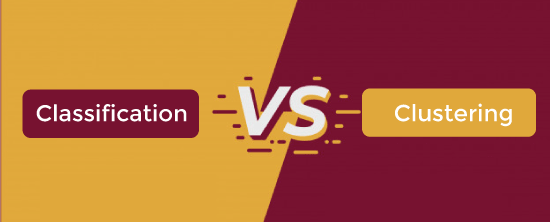Difference between classification and clustering in data mining
The primary difference between classification and clustering is that classification is a supervised learning approach where a specific label is provided to the machine to classify new observations. Here the machine needs proper testing and training for the label verification. So, classification is a more complex process than clustering. On the other hand, clustering is an unsupervised learning approach where grouping is done on similarities basis. Here the machine learns from the existing data and does not need any training. In this article, we will discuss the two-term classification and clustering separately; after that, we will see the major differences.
What is classification?
The term “classification” is usually used when there are exactly two target classes called binary classification. When more than two classes may be predicted, specifically in pattern recognition problems, this is often referred to as multinomial classification. However, multinomial classification is also used for categorical response data, where one wants to predict which category amongst several categories has the instances with the highest probability.
Classification is one of the most important tasks in data mining. It refers to a process of assigning pre-defined class labels to instances based on their attributes. There is a similarity between classification and clustering, it looks similar, but it is different. The major difference between classification and clustering is that classification includes the levelling of items according to their membership in pre-defined groups. Let’s understand this concept with the help of an example; suppose you are using a self-organizing map neural network algorithm for image recognition where there are 10 different kinds of objects. If you label each image with one of these 10 classes, the classification task is solved.
On the other hand, clustering does not involve any labelling. Assume that you are given an image database of 10 objects and no class labels. Using a clustering algorithm to find groups of similar-looking images will result in determining clusters without object labels.
Classification of data mining
These are given some of the important data mining classification methods:
Logistic Regression Method
The logistic Regression Method is used to predict the response variable.
K-Nearest Neighbors Method
K-Nearest Neighbors Method is used to classify the datasets into what is known as a K observation. It is used to determine the similarities between the neighbours.
Naive Bayes Method
The Naive Bayes method is used to scan the set of data and locate the records wherein the predictor values are equal.
Neural Networks Method
The Neural Networks resemble the structure of our brain called the Neuron. The sets of data pass through these networks and finally come out as output. This neural network method compares the different classifications. Errors that occur in the classifications are further rectified and are fed into the networks. This is a recurring process.
Discriminant Analysis Method
In this method, a linear function is built and used to predict the class of variables from observation with the unknown class.
What is clustering?
Clustering refers to a technique of grouping objects so that objects with the same functionalities come together and objects with different functionalities go apart. In other words, we can say that clustering is a process of portioning a data set into a set of meaningful subclasses, known as clusters. Clustering is the same as classification in which data is grouped. Though, unlike classification, the groups are not previously defined. Instead, the grouping is achieved by determining similarities between data according to characteristics found in the real data. The groups are called Clusters.
Methods of clustering
- Partitioning methods
- Hierarchical clustering
- Fuzzy Clustering
- Density-based clustering
- Model-based clustering
Difference between Classification and Clustering

| Classification | Clustering |
|---|---|
| Classification is a supervised learning approach where a specific label is provided to the machine to classify new observations. Here the machine needs proper testing and training for the label verification. | Clustering is an unsupervised learning approach where grouping is done on similarities basis. |
| Supervised learning approach. | Unsupervised learning approach. |
| It uses a training dataset. | It does not use a training dataset. |
| It uses algorithms to categorize the new data as per the observations of the training set. | It uses statistical concepts in which the data set is divided into subsets with the same features. |
| In classification, there are labels for training data. | In clustering, there are no labels for training data. |
| Its objective is to find which class a new object belongs to form the set of predefined classes. | Its objective is to group a set of objects to find whether there is any relationship between them. |
| It is more complex as compared to clustering. | It is less complex as compared to clustering. |
